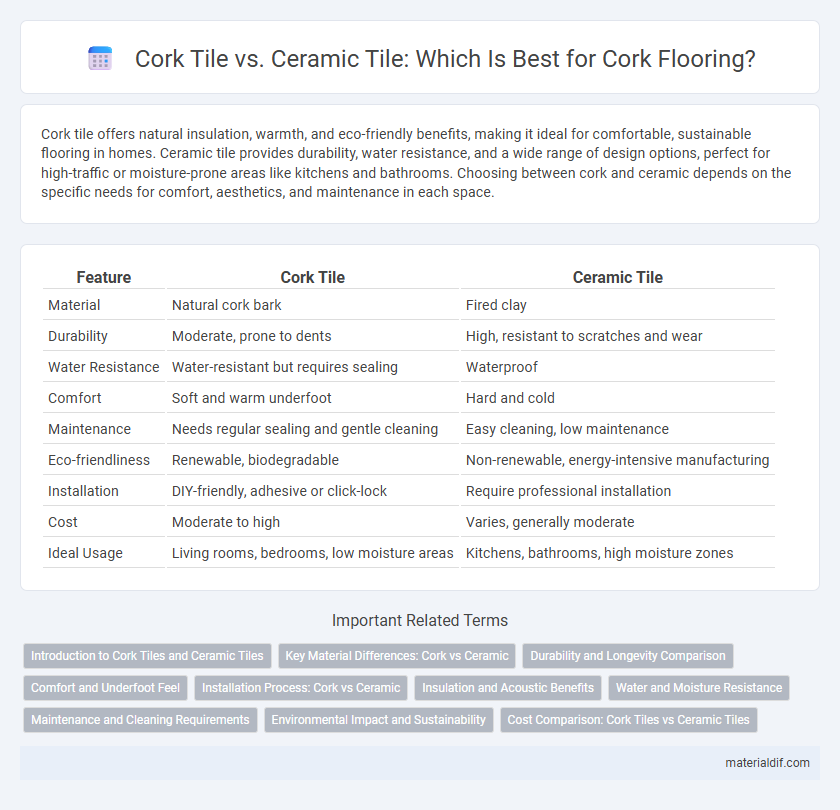Cork tile offers natural insulation, warmth, and eco-friendly benefits, making it ideal for comfortable, sustainable flooring in homes. Ceramic tile provides durability, water resistance, and a wide range of design options, perfect for high-traffic or moisture-prone areas like kitchens and bathrooms. Choosing between cork and ceramic depends on the specific needs for comfort, aesthetics, and maintenance in each space.
Table of Comparison
| Feature | Cork Tile | Ceramic Tile |
|---|---|---|
| Material | Natural cork bark | Fired clay |
| Durability | Moderate, prone to dents | High, resistant to scratches and wear |
| Water Resistance | Water-resistant but requires sealing | Waterproof |
| Comfort | Soft and warm underfoot | Hard and cold |
| Maintenance | Needs regular sealing and gentle cleaning | Easy cleaning, low maintenance |
| Eco-friendliness | Renewable, biodegradable | Non-renewable, energy-intensive manufacturing |
| Installation | DIY-friendly, adhesive or click-lock | Require professional installation |
| Cost | Moderate to high | Varies, generally moderate |
| Ideal Usage | Living rooms, bedrooms, low moisture areas | Kitchens, bathrooms, high moisture zones |
Introduction to Cork Tiles and Ceramic Tiles
Cork tiles are made from natural cork bark, known for their eco-friendly properties, insulation, and sound absorption, making them ideal for sustainable flooring solutions. Ceramic tiles, composed of clay and other minerals baked at high temperatures, offer durability, water resistance, and a wide range of styles suitable for bathrooms and kitchens. Both materials provide unique benefits, with cork emphasizing comfort and sustainability, while ceramic excels in hardness and moisture resistance.
Key Material Differences: Cork vs Ceramic
Cork tile is made from the bark of the cork oak tree, offering natural insulation, flexibility, and a softer surface, while ceramic tile is composed of natural clay baked at high temperatures, resulting in a hard, brittle, and highly durable flooring option. Cork provides superior thermal and acoustic properties, making it energy-efficient and quieter underfoot compared to ceramic, which excels in water resistance and ease of cleaning. The organic and renewable nature of cork makes it an eco-friendly choice, whereas ceramic tile is valued for its longevity and resistance to stains and scratches.
Durability and Longevity Comparison
Cork tile offers exceptional resilience due to its natural elasticity, making it highly durable against impacts and offering superior longevity in moderate traffic areas. Ceramic tile, crafted from fired clay, excels in hardness and scratch resistance, providing unmatched durability in high-traffic and moisture-prone environments. While cork tiles require sealing to enhance water resistance, ceramic tiles maintain their integrity for decades with minimal maintenance, making them ideal for long-term use.
Comfort and Underfoot Feel
Cork tile offers superior comfort and a cushioned underfoot feel due to its natural elasticity and cellular structure, making it softer and warmer than traditional ceramic tile. Ceramic tile, being hard and rigid, lacks the shock-absorbing qualities of cork, often resulting in a cooler and less forgiving surface underfoot. The thermal insulation properties of cork also enhance comfort by maintaining consistent warmth, ideal for spaces where prolonged standing occurs.
Installation Process: Cork vs Ceramic
Cork tile installation involves laying down a moisture-resistant underlayment and using adhesive or a click-lock system, making it relatively straightforward and suitable for DIY projects due to its flexibility and lightweight nature. Ceramic tile installation requires precise subfloor preparation, thin-set mortar application, and grout filling, necessitating professional skills for durability and water resistance, especially in wet areas. Cork tiles offer easier and faster installation with minimal grout lines, while ceramic tiles demand meticulous alignment and curing time for long-lasting performance.
Insulation and Acoustic Benefits
Cork tile offers superior thermal insulation compared to ceramic tile, maintaining room warmth and reducing energy costs effectively. Its natural sound-absorbing properties minimize noise transmission, creating quieter indoor environments. Ceramic tile, while durable and moisture-resistant, lacks the insulating and acoustic benefits that make cork tile ideal for cozy, sound-controlled spaces.
Water and Moisture Resistance
Cork tile offers superior natural water and moisture resistance due to its cellular structure filled with suberin, a waxy substance that repels water, making it ideal for damp environments like bathrooms and kitchens. Ceramic tile is highly resistant to water due to its glazed surface, preventing moisture penetration and making it a popular choice for wet areas. While both materials resist moisture, cork's resilience combined with its warmth and cushioning provides added comfort in spaces prone to humidity.
Maintenance and Cleaning Requirements
Cork tile requires gentle cleaning with a damp mop and pH-neutral cleaners to prevent damage, while ceramic tile can withstand more rigorous scrubbing and a wider variety of cleaning agents. Cork's natural porous surface necessitates regular sealing every few years to maintain its durability and moisture resistance, whereas ceramic tiles need only occasional grout resealing. Both materials demand prompt spill cleanup to avoid staining, but cork is more sensitive to excessive water exposure compared to the water-resistant ceramic tile.
Environmental Impact and Sustainability
Cork tile is highly sustainable due to its renewable harvesting from the bark of cork oak trees, which regenerates without harming the tree, making it an eco-friendly alternative to ceramic tile. Unlike ceramic tile, which requires high-temperature kilns and significant energy consumption during production, cork tile manufacturing has a lower carbon footprint and produces less waste. Cork tiles are biodegradable and recyclable, contributing to reduced landfill impact, whereas ceramic tiles often end up as non-biodegradable construction debris.
Cost Comparison: Cork Tiles vs Ceramic Tiles
Cork tiles generally cost between $3 and $7 per square foot, making them a moderately priced flooring option compared to ceramic tiles, which range from $1 to $15 per square foot depending on quality and design. Installation costs for cork tend to be lower due to easier handling and cutting, whereas ceramic tile installation can be more labor-intensive and expensive, often requiring skilled labor. Over time, cork tiles offer savings through natural insulation and durability, while ceramic tiles may incur additional costs from potential cracking and grout maintenance.
Cork Tile vs Ceramic Tile Infographic

 materialdif.com
materialdif.com